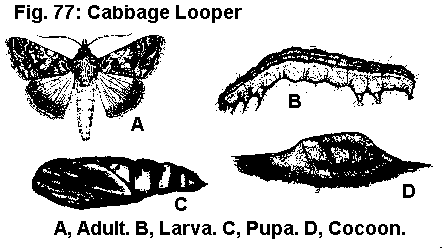DESCRIPTION Adult- The adult cabbage looper is a grayish-brown moth with a wingspan up to 33 mm. The forewings have a distinct irregular, white mark. Egg- When first deposited, the eggs are white but darken as they get older. The eggs are hemispherical with fine transverse lines and longitudinal ribs. Larva- Newly hatched larvae are whitish with a black head and shield immediately posterior to the head. As the larvae grow, they become light green with two dorsal white stripes and two wider lateral white stripes. The markings become less distinct in the last instar. The body tapers toward the head, and the full grown larva is 35 to 40 mm long. Pupa- Easily seen through the webby cocoon, the pupa is light green when first formed and darkens to almost black later
Fig. 77: Cabbage Looper, Trichoplasia
ni (Hubner), Noctuidae, LEPIDOPTERA BIOLOGY Distribution- The cabbage looper is found throughout the United States. Host Plants- The cabbage looper larva is a general feeder with a wide range of possible food plants. Some hosts are cabbage, carnation, snapdragon, nasturtium, mignonette, celery, tomato, beet, pea, and lettuce. Damage- On some plants the larva has a distinctive feeding habit. The holes it makes are arc-shaped. The area of the hole is determined by the size of the larva that made it. The characteristic pattern is caused by the larva partly cutting the leaf as far as it can reach by holding fast with its hind legs. Life History-Because the larva of the cabbage looper lacks 2 pairs of prolegs, it is necessary for the caterpillar to arch its back in a looping fashion to move, hence the common name looper. Eggs are deposited singly on either side of the leaf by the cabbage looper. Each female is capable of producing 200 or more eggs. Hatching occurs 3 to 10 days after the eggs are laid. There are four or five larval instars that develop in 10 to 50 days. If food is abundant and environmental conditions are favorable, only four instars develop. The larvae are strong crawlers and will travel some distance to reach a new host. If disturbed, the caterpillars characteristically curl into a ball and drop from the plant. Pupae are formed within a thin, white cocoon that may be attached to different objects or under a clod of soil. The pupal stage lasts from 6 days to as long as several months (overwintering stage). The adults are strong fliers and are active about dusk and on cloudy and cool fall days. The moths avoid strong sunlight. CONTROL A number of parasitic wasps and flies attack cabbage looper caterpillars, and birds and bats feed on the adult moths. For specific chemical control recommendations, consult current Cooperative Extension Service publications. |
